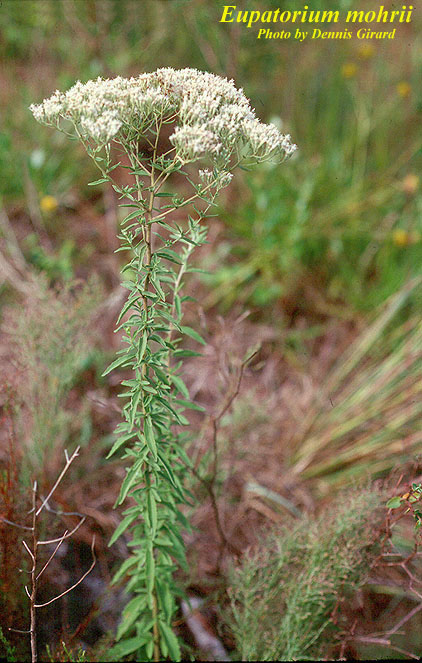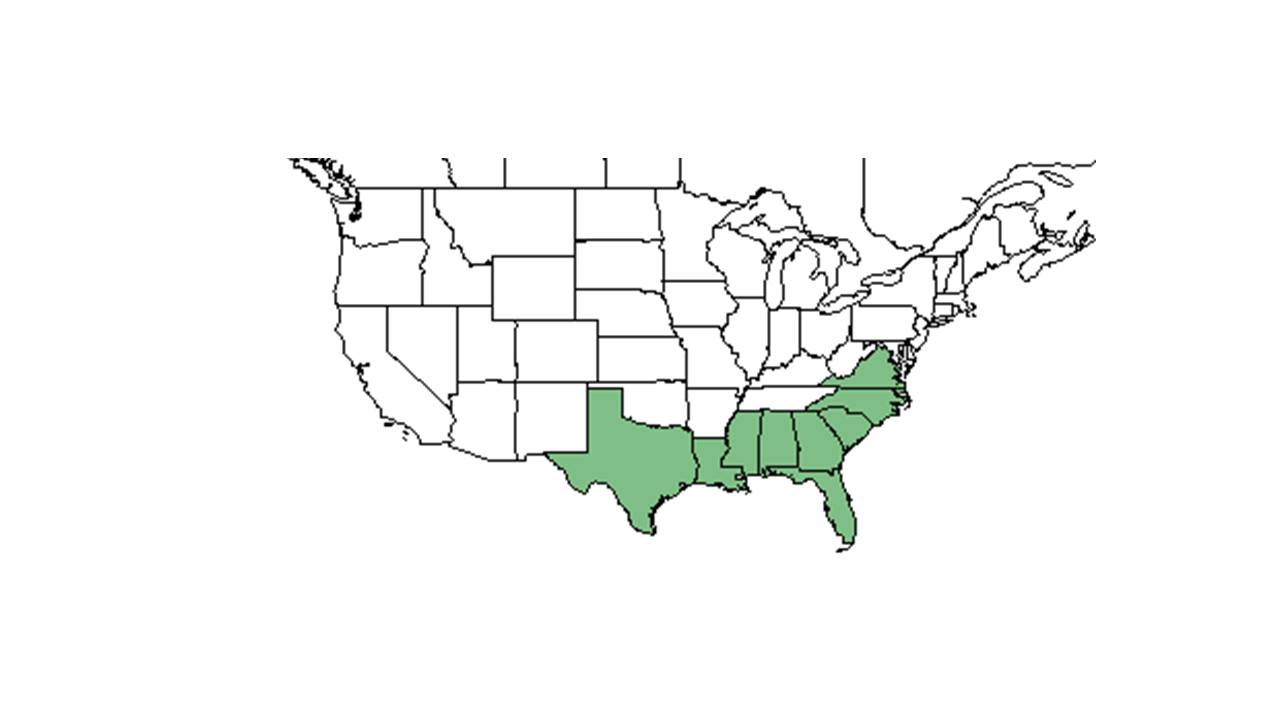Difference between revisions of "Eupatorium mohrii"
(→Pollination) |
(→Ecology) |
||
| Line 38: | Line 38: | ||
<!--===Seed dispersal===--> | <!--===Seed dispersal===--> | ||
<!--===Seed bank and germination===--> | <!--===Seed bank and germination===--> | ||
| − | + | ||
| + | ===Fire ecology=== <!--Fire tolerance, fire dependence, adaptive fire responses--> | ||
| + | This species commonly occurs in pinelands that are fire-dependent.<ref>Carr, S. C., et al. (2010). "A Vegetation Classification of Fire-Dependent Pinelands of Florida." Castanea 75(2): 153-189.</ref> | ||
===Pollination=== | ===Pollination=== | ||
Revision as of 19:15, 10 May 2019
| Eupatorium mohrii | |
|---|---|

| |
| Photo by Dennis Girard, Atlas of Florida Vascular Plants | |
| Scientific classification | |
| Kingdom: | Plantae |
| Division: | Magnoliophyta - Flowering plants |
| Class: | Magnoliopsida – Dicotyledons |
| Order: | Asterales |
| Family: | Asteraceae ⁄ Compositae |
| Genus: | Eupatorium |
| Species: | E. mohrii |
| Binomial name | |
| Eupatorium mohrii Greene | |

| |
| Natural range of Eupatorium mohrii from USDA NRCS Plants Database. | |
Common name: Mohr's thoroughwort; Mohr's Eupatorium
Contents
Taxonomic notes
Synonym: Eupatorium recurvans Small; E. anomalum Nash
Description
A description of Eupatorium mohrii is provided in The Flora of North America.
Distribution
This species is distributed from southeast Virginia south to southern Florida and west to Texas.[1]
Ecology
Habitat
Generally, E. mohrii can be found in moist savannas as well as other wet habitats.[1] Native, perennial herb in longleaf pine stands.[2] It does well in open canopy areas on longleaf pine habitats. Does not do well in highly disturbed areas (such as clear cutting).[3] It is found areas that have become wet in some parts of the year such as in slash pine flatwoods, hammocks, near creeks, pond-pine scrubs, peaty pine savannas, wet flatwoods, swampy depressions between sand ridges, pine-palmetto flatwoods, upper edges of hillside bogs, edges of titi bogs, swales and dunes, and in river floodplains. It is also found in human disturbed areas such as pinelands that have been clear cut, along roadside depressions, embankments, edges of an artificial pond, and in powerline corridors. It is associated with areas that have moist soil, moist sandy peaty soil, semi-wet soil, muckly aulluvium soils, and moist sandy clay.[4]
Associated species include Eupatorium rotundifolium, E. album, E. cuneifolium, E. leucolepis, E. recurvans, E. mikaniodes, Andropogon, Aster dumosus, Ludwigia virgata, Carex joorii, Panicum rigidulum, Rhexia mariana, Rubus cuneifolius, Magnolia virginina, Pinus palutris, P. elliottii, P. taeda, Serenoa repens, Aristida stricta, Quercus, Liquidambar styraciflua, Cyrilla racemiflora.[4]
Phenology
E. mohrii generally flowers from August until October.[1] It has been observed flowering from June to November.[5][4]
Fire ecology
This species commonly occurs in pinelands that are fire-dependent.[6]
Pollination
The following Hymenoptera families and species were observed visiting flowers of Eupatorium mohrii at Archbold Biological Station: [7]
Apidae: Apis mellifera, Bombus impatiens
Halictidae: Agapostemon splendens, Halictus poeyi
Leucospididae: Leucospis robertsoni, L. slossonae
Megachilidae: Coelioxys mexicana, Dianthidium floridiense, Megachile albitarsis
Sphecidae: Bicyrtes capnoptera, B. insidiatrix, Cerceris blakei, Philanthus ventilabris, Prionyx thomae, Tachytes pepticus, T. validus
Vespidae: Pachodynerus erynnis
E. mohrii also attracts various butterflies as a nectar source for pollination.[8] Thick-headed flies in the genus Physoconops were collected from the flowers of E. mohrii and possibly pollinate the plant as well.[9]
Conservation and management
Cultivation and restoration
Photo Gallery
References and notes
- ↑ 1.0 1.1 1.2 Weakley, A. S. (2015). Flora of the Southern and Mid-Atlantic States. Chapel Hill, NC, University of North Carolina Herbarium.
- ↑ Harrington, T. B. (2011). "Overstory and understory relationships in longleaf pine plantations 14 years after thinning and woody control." Canadian Journal of Forest Research 41: 2301-2314.
- ↑ Brockway, D. G. and C. E. Lewis (2003). "Influence of deer, cattle grazing and timber harvest on plant species diversity in a longleaf pine bluestem ecosystem." Forest Ecology and Management 175: 49-69.
- ↑ 4.0 4.1 4.2 Florida State University Robert K. Godfrey Herbarium database. URL: http://herbarium.bio.fsu.edu. Last accessed: June 2014. Collectors: R.K. Godfrey, Loran C. Anderson, A. F. Clewell, Clarke Hudson, R.L. Lazor, J. P. Gillespie, D. S. Correll, P. L. Redfearn, Jr., Sid McDaniel, J. Lazor, Jean W. Wooten, V. I. Sullivan, J. Britten, B. K. Holst, Cruz, Montero, C. Jackson, R. Kral, Roomie Wilson, B F Hansen, JoAnn Hansen, Carol Havlik, Ann F. Johnson, Chet Winegarner, Marsha Winegarner, S. C. Hood, R. A. Norris, R. Komarek, and Annie Schmidt. States and Counties:Florida: Bay, Brevard, Citrus, Clay, Columbia, Dixie, Flagler, Franklin, Gulf, Hamilton, Holmes, Jefferson, Leon, Levy, Liberty, Martin, Okaloosa, Putnam, Santa Rosa, Sarasota, St. John’s, Suwannee, Taylor, Union, Wakulla, Walton, and Washington. Georgia: Atkinson, Brantley, Camden, Charlton, Clinch, Decatur, Echols, Grady, Thomas, and Ware.
- ↑ Nelson, G. PanFlora: Plant data for the eastern United States with emphasis on the Southeastern Coastal Plains, Florida, and the Florida Panhandle. www.gilnelson.com/PanFlora/ Accessed: 9 DEC 2016
- ↑ Carr, S. C., et al. (2010). "A Vegetation Classification of Fire-Dependent Pinelands of Florida." Castanea 75(2): 153-189.
- ↑ Deyrup, M.A. and N.D. 2015. Database of observations of Hymenoptera visitations to flowers of plants on Archbold Biological Station, Florida, USA.
- ↑ [[1]] Lady Bird Johnson Wildflower Center. Accessed: May 10, 2019
- ↑ Clouse, R. M., et al. (1997). "Observations of insects associated with an infestation of sand pine (Pinus clausa) by the aphid Cinara pinivora." Florida Scientist 60(2): 89-93.